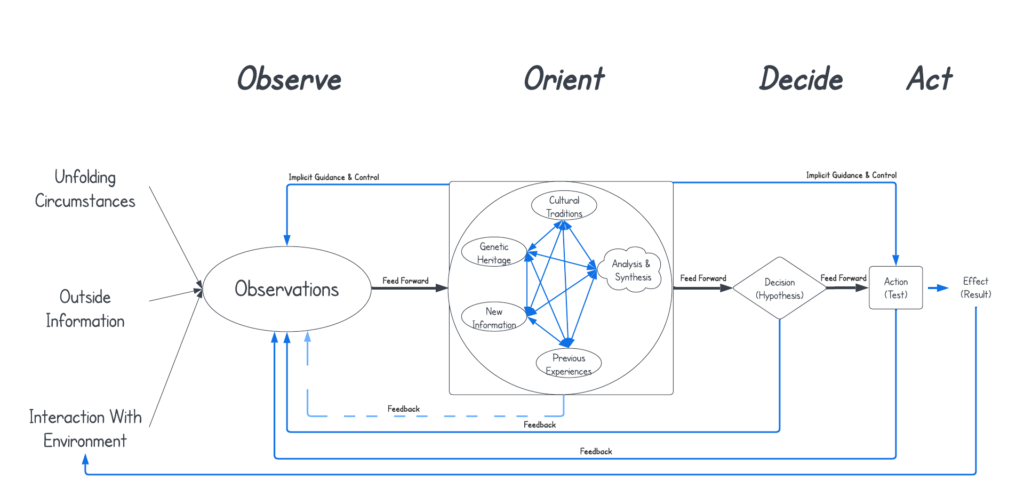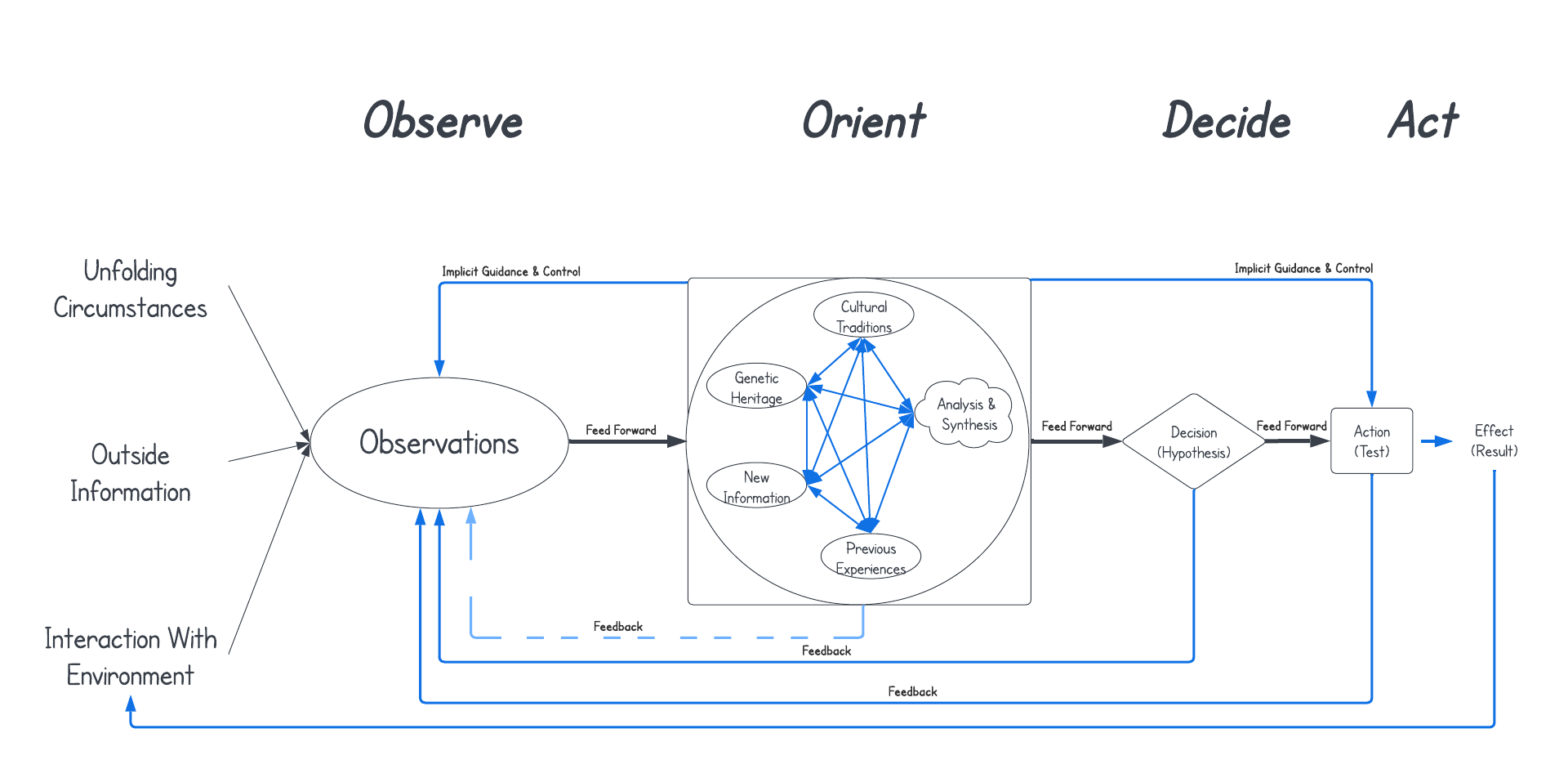Analytics & Decision Making
With the increased use of empirical evidence as the basis for our understanding of the world, analytics has become the cornerstone of our decision making. Data Driven Decision making is driving innovation and improvement in science, engineering, business and public sector.
To understand the role of analytics we need to understand the process of decision making. A useful description of how people make decisions can be drawn from John Boyd’s OODA loop [1]
Data Driven Decision making is driving innovation and improvement in science, engineering, business and public sector.“
John Boyd’s OODA Loop
Boyd describes the process of decision making as a set of interwoven activities that he named Observe – Orient – Decide – Act. He developed the model based on his observations of how fighter pilots make their choices in air-to-air combat [2]. In this OODA loop Boyd describes how decision makers gain situational awareness by continuously iterate through a series of embedded loops.
Boyd describes the process of decision making as a set of interwoven activities that he named Observe – Orient – Decide – Act“
In his article “Destruction and Creation” [3] he explains how he views the process of decision making as continuously creating, adapting and destroying mental concepts that represent patterns that we perceive in observations. We create new concepts when we observe something new. A process he links to a bottom up, or specific-to-general, discovery process that he names “creative (or constructive) induction”. We then need to check our consistency in describing reality as we perceive is using a top down, or general-to-specific, (deductive) analysis to see if our current understanding matches perceived reality. If the match fails, we need to adapt or destroy our current mental concept and rebuild it. Boyd calls this process “deductive destruction”. This continuous cycle of creation and destruction continues until we have a consistent mental concept that matches reality. When we reach this state we are in the happy place that allows us to understand a part of observed reality and make decisions based on that.
The process of decision making as continuously creating, adapting and destroying mental concepts that represent patterns that we perceive in observations“
Boyd warns for the danger that we can then become entangled within our own mental concept while reality might not allow for that. As he states: “we should anticipate a mismatch between phenomena observation and concept description of that observation” [3] and we need to be willing to go through the “Create – Destroy” cycle again. His reasoning is based on 3 key principles in science:
- Gödel’s Incompleteness Theorem: Gödel showed that any logical system can only be shown to be consistent by using another system beyond it. Because of this our observations are also incomplete. We need to continuously refine/adapt/destroy our mental concept based on new observations.
- Heisenberg’s Uncertainty Principle: Heisenberg showed the impossibility to measure reality with certainty due to the role of the observer: “the uncertainty values not only represent the degree of intrusion by the observer upon the observed but also the degree of confusion and disorder perceived by that observer” [3].
- Second Law of Thermodynamics: this law states that any closed system has entropy increases. Entropy describes the degree of order in a system High entropy refers to disorder, low entropy to order.
danger that we can then become entangled within our own mental concept while reality might not allow for that“
Based on these principles Boyd concludes: “According to Gödel we cannot—in general—determine the consistency, hence the character or nature, of an abstract system within itself. According to Heisenberg and the Second Law of Thermodynamics any attempt to do so in the real world will expose uncertainty and generate disorder. Taken together, these three notions support the idea that any inward-oriented and continued effort to improve the match-up of concept with observed reality will only increase the degree of mismatch.” [3] His solution for this problem is the “Dialectic Engine”: a continuous loop between destructive/deductive and creative/inductive thinking to create mental concepts that entities can use as decision models for deciding acting, monitoring and coping with situations and environments.
In his 1995 summary of his thinking [4] Boyd draws a ‘sketch’ of, what he thinks, best describes human insight building & decision making with the OODA loop. In Figure 1The OODA “Loop” Sketch I have reproduced the original loop as drawn by Boyd.

- He annotates this sketch with 2 important remarks: “Note how orientation shapes observation, shapes decision, shapes action, and, in turn, is shaped by the feedback and other phenomena coming into our sensing or observation window”
- “Also note how the entire ‘loop’ (not just orientation) is an ongoing many-sided implicit cross-referencing process of projection, empathy, correlation, and rejection”
Decision making is a continuous learning loop
In their paper “Improving Digital Decision Making Through Situational Awareness” Noran & Bernus [4] quite rightly state: “this ‘loop’ is often misunderstood to be a strict sequence of tasks”. The many internal feedback loops and the additional annotations to his sketch indicate that Boyd clearly envisions decision making as a continuous learning process.
In a future article I’ll describe the importance of using this ‘framework’ in describing decision making in organizations in an Organizational OODA Loop.
Boyd clearly envisions decision making as a continuous learning process“
References
[1] J. R. Boyd, “The Essence of Winning and Losing,” 28 June 1995 (rev. 1996). [Online]. Available: https://www.danford.net/boyd/essence.htm. [Accessed 13 July 2020].
[2] J. R. Boyd and G. T. Hammond (editor), “A Discourse on Winning and Losing,” 12 June 2018. [Online]. Available: https://www.airuniversity.af.edu/Portals/10/AUPress/Books/B_0151_Boyd_Discourse_Winning_Losing.PDF. [Accessed 6 July 2020].
[3] J. R. Boyd, “Destruction & Creation,” 3 September 1976. [Online]. Available: http://www.goalsys.com/books/documents/DESTRUCTION_AND_CREATION.pdf. [Accessed 6 July 2020].
[4] O. Noran and P. Bernus, ” Improving Digital Decision Making Through Situational Awarenes,” in Information Systems Development: Designing Digitalization (ISD2018 Proceedings), Lund, Lund University, 2018.

